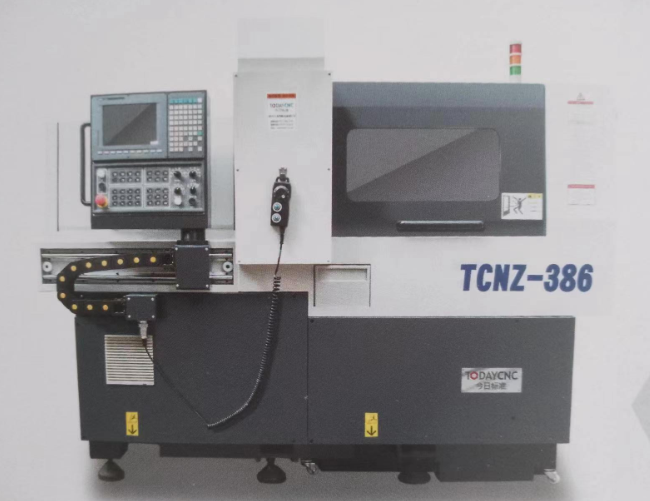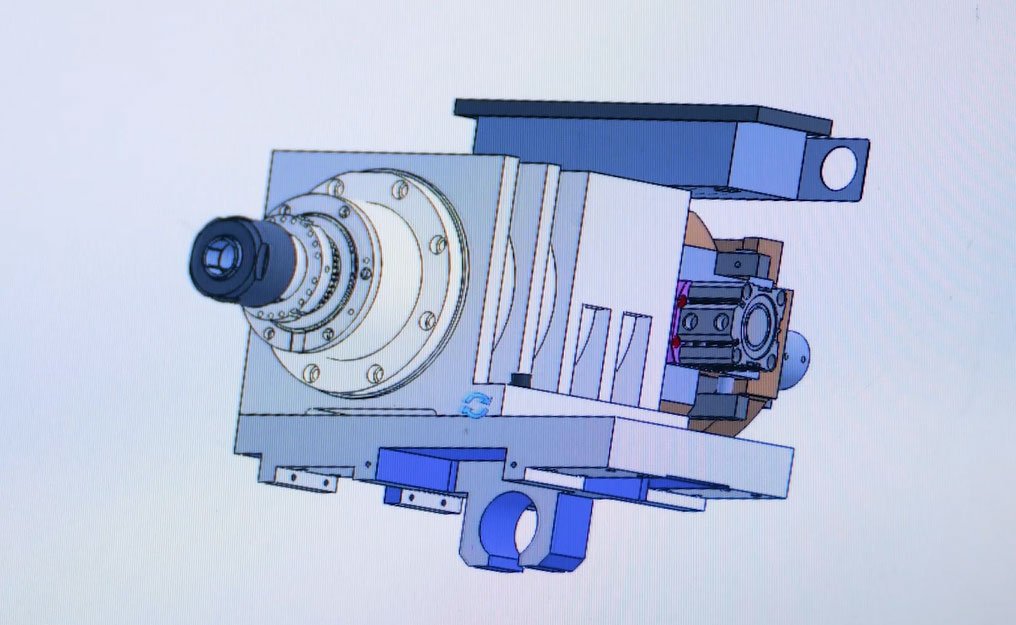With the continuous advancement of related technologies such as design, manufacturing, assembly and materials of CNC machine tools and parts, the proportion of geometric errors, tool wear, servo and other errors in the overall errors of CNC machine tools is gradually decreasing. Under extreme high-speed, high-precision machining conditions, thermal deformation has increasingly become an important factor affecting the machining accuracy of machine tools. A large amount of research and processing practice shows that for high-speed and high-precision machine tools, the proportion of processing and manufacturing errors caused by thermal deformation is 40% to 70%, and thermal problems have become a key factor affecting the accuracy of machine tools. In order to reduce the impact of thermal deformation of machine tools on machining accuracy and accuracy stability, comprehensive analysis and optimization are required from the aspects of design, manufacturing and use. There are two main methods to reduce the thermal error of machine tools: one is to improve the thermal characteristics of the machine tool during the design stage; the other is to compensate for the thermal error of the machine tool during the operation stage. The most commonly used one at present is thermal error compensation based on thermal deformation in CNC systems. The thermal error compensation method can improve processing accuracy within a certain range and help reduce design and manufacturing costs. However, it is a passive and ex post compensation method, and its compensation scope and effectiveness have certain limitations. When the thermal characteristics of a machine tool are relatively poor, subsequent thermal compensation alone cannot meet the machining accuracy requirements. To improve the accuracy and thermal performance of machine tools, we must start from improving the thermal characteristics and thermal stiffness of machine tools in the design stage, realize active thermal control of machine tools, and fundamentally improve the thermal performance of machine tools. Although people have begun to study the thermal characteristics of machine tools since the 1940s, because traditional machine tools are not as high in accuracy and speed as modern manufacturing requirements, thermal problems are not serious, and due to the variety of machine tools and their component types and loads, The complexity of the structure, temperature field and thermal deformation of the machine tool are affected by many factors. Therefore, its research is generally focused on specific machine tools, using experimental research methods or numerical simulation methods to analyze various heat sources of the machine tool and their impact on the machine tool temperature. Due to the influence of the field, the thermal design of machine tools has formed a phenomenon of "treating the head when it hurts and treating the foot when it hurts". There is no systematic theory, method and analysis tool. This is obviously incompatible with the current requirements for the high-speed and high-precision development of machine tools. .
The core goal of machine tool thermal design is to control temperature rise to the maximum extent, reduce thermal deformation, provide a good thermal environment for component level, assembly level and system level, and ensure that they work reliably according to predetermined requirements under a certain thermal environment. . Thermal design of machine tools is generally divided into two categories, one is the thermal balance and optimization design technology of the machine tool structure, and the other is the high-efficiency cooling technology of the machine tool.
2 Thermal balance and optimization design technology of machine tool structure
Toshio Sada of the University of Tokyo, Japan, and others regarded the thermal deformation of machine tools as insufficient structural stiffness of machine tools due to temperature changes. They proposed the concept of "thermal stiffness" and combined the three aspects of static stiffness, dynamic stiffness and thermal stiffness of machine tools. issues should be studied together. The thermal stiffness of a machine tool is the ratio of the temperature rise to the thermal deformation value when the machine tool reaches thermal equilibrium. It represents the machine tool's ability to resist thermal deformation and is a characteristic quantity that characterizes the thermal characteristics of the machine tool. Since the thermal stiffness of different parts has different effects on the thermal stiffness of the whole machine, Yang Hong and others from Sichuan University proposed the concept of key thermal stiffness of machine tools and proposed a key thermal stiffness of machine tools based on the thermal error neural network prediction model. The stiffness identification method provides a basis for rational distribution of machine tool thermal stiffness and optimization of thermal stiffness of machine tool components. The thermal stiffness of all parts of the machine tool constitutes the thermal stiffness of the entire machine. The introduction of the concept of thermal stiffness unifies the stiffness concept of traditional mechanics and has important guiding significance for the formation of unified design concepts and methods. Based on the concept of thermal stiffness, the main content of the thermal balance design of the machine tool structure is to use the structural size as the design variable, the displacement of thermal deformation such as bending and torsion as the objective function, and optimize the design with the goal of improving the thermal stiffness of the components and the overall machine tool. When thermally designing a machine tool, it is necessary to start with the main thermal deformation parts of the machine tool based on the thermal characteristics of the machine tool, that is, focus on key heating areas and heat-sensitive parts. Common ones include the thermal expansion of the spindle, the thermal deformation of the spindle box, and the thermal elongation of the ball screw. As well as the thermal tilt of the column, etc., through structural thermal balance design of these key components, the overall thermal deformation of the machine tool can be grasped, and then the overall optimization, balanced structure and symmetrical structural design can be carried out. Based on its 20 years of research and development experience in thermal deformation treatment, Japan's OKUMA Company proposed the concept of "thermal affinity". "Thermo-affiliation" refers to the concept of living in harmony with heat. Previous measures taken for machine tools were mainly focused on how to reduce the amount of heat generated or how to cool down. The concept of "thermal affinity" is to accept heat while minimizing heat generation and utilize heat rationally. Although it is difficult to predict complex thermal deformation, through the machine tool structure of "simplification of thermal deformation" and "uniformization of temperature distribution", predictable and regular thermal displacement can be achieved, and thermal structure balance compensation control can be accurately performed even without a constant temperature chamber. Such as large-scale equipment, can also form a stable thermal structure and maintain high accuracy. The idea of "thermal affinity" is to rationally utilize heat to achieve regular and controllable thermal deformation. It can enable the machine tool to maintain the same thermal balance structure when the temperature changes and suppress thermal deformation to a minimum. Commonly used structures are the "thermal symmetry structure" centered on the processing point, the "box combination structure" that simplifies the shape of the components, and the "thermal balanced structure" that evens out the temperature distribution through a reasonable layout of the cover and ancillary units. . If the spindle adopts a simple thermal deformation structure, apply the correct thermal displacement compensation method so that the spindle can keep the thermal deformation within 4 μm during long-term operation. Adopting a reasonable thermodynamic structure, whether it is the temperature change of the machine tool caused by cutting processing, motor drive and component movement, or the temperature change caused by cutting fluid, workshop environment, etc., the machine tool will regularly expand and contract according to the predicted direction and displacement, so that It lays the foundation for reasonable thermal control.
Yoshida Kataro proposed the concept of "thermally neutral axis" in 1973. He believed that the thermal displacement of the spindle will vary due to changes in the heat source and support method in the spindle box. Therefore, efforts should be made to maintain the spindle position unchanged under the thermal deformation state of the machine tool. change, thereby improving the thermal accuracy of the machine tool. Later, he further developed this concept into the concept of "thermal symmetry plane", arranging the parts that most affect the machining accuracy on the thermal symmetry plane, which greatly improved the poor machining accuracy caused by thermal deformation. Using this theory, he designed a double-sided The column clamp box structure is a typical thermally symmetrical structure, which can avoid the thermal tilt of the spindle that often occurs in general single-column machine tools. Switzerland also attaches great importance to the influence of heat sources on machine tools in machine tool design and advocates symmetrical distribution of heat sources. If a machine tool is only equipped with a fuel tank or motor on one side, the machine tool will easily tilt due to heat; if the motors are symmetrically arranged on both sides of the machine tool to ensure uniform heating conditions on both sides, there will be no left or right tilt. As the main basic parts of machine tools, the mechanical and thermal properties of the column, bed, and spindle box have a great impact on the machining accuracy and accuracy stability of the machine tool. Research in this area shows that the asymmetry of the spindle box deformation will cause the spindle axis to shift or produce a deflection angle; increasing the local thickness and changing the layout of the ribs can reduce the weight of the bed while improving the structural deformation of the bed. . Reasonable selection of column structural size parameters can improve its thermal stiffness. Thermal symmetry design of basic parts (structural symmetry design and heat source distribution symmetry design) is an effective measure to reduce harmful thermal deformation.
In addition, heat capacity balance design is also an effective method to improve thermal deformation. It is based on the difference in heat capacity of each component of the machine tool. Certain measures are taken to control and reduce the temperature rise of components with large local heat capacity, so that there will not be a large temperature difference between them and parts with small heat capacity, and try to achieve a thermal balance between them. , thereby reducing the overall thermal deformation of the machine tool. Properly designing the machine tool heat sink is beneficial to balancing the temperature field between components.
In addition, the thermal structure optimization technology of machine tools also includes anti-deformation technology. In addition, the use of new materials such as granite, ceramics, concrete, and fiberglass can also reduce thermal deformation. Using anti-deformation to offset the adverse effects of thermal deformation is a simple, easy and effective method. Taking a certain surface grinder as an example, Hohhot No. 3 Machine Tool Factory proactively adopted a convex structure for the machine tool guide rail during processing, which greatly improved the stability of the grinder's processing accuracy. Another important method of thermal design of machine tools is to design an efficient cooling system to improve the accuracy of the machine tool by controlling the temperature changes of the machine tool.
3 Machine tool cooling design technology
Advanced cooling systems are an important means to improve the thermal accuracy of machine tools. The design of the cooling system mainly includes efficient cooling structure design, efficient cooling medium selection and adaptive cooling control system. Generally, the heat sources of machine tools are located in different parts and are an unbalanced body. Therefore, the key components that mainly generate heat are cooled according to different working conditions.
3.1 Spindle cooling technology
High-speed, precision CNC machine tool spindle systems mostly use electric spindles, but the structure of high-speed electric spindles has heat dissipation defects. This is because the high-speed electric spindle has a built-in motor and a closed casing, which makes it difficult to quickly dissipate a large amount of heat generated by the motor and bearings. The heat generated by the bearings increases as the spindle speed increases, causing deformation of both the spindle and the bearings. Therefore, controlling the temperature rise and reducing the thermal expansion of the electric spindle are the main problems of the electric spindle. Scholars at home and abroad have conducted a lot of research on the thermal characteristics of electric spindles. The cooling measures to improve the thermal deformation of the spindle mainly include the following aspects.
(1) Improve cooling design. The traditional cooling method for high-speed spindles is to add cooling oil in the spiral holes of the spindle housing for forced convection cooling, and continuously circulate to take away the heat. However, this method has low cooling efficiency and cannot directly take away the heat of the spindle core and rotor. In order to further reduce the thermal expansion of the electric spindle shaft core, the researchers designed an electric spindle with a shaft core cooling design. Due to the characteristics of heat pipes such as efficient thermal conductivity, temperature uniformity and structural diversity, they have been widely used in recent years to cool the shell and shaft core of high-speed electric spindles.
(2) Equilibrium temperature. For situations where the heat source of the spindle is difficult to control, increase the temperature near the heat source so that the heat from the higher-temperature position of the spindle can be transferred to the lower-temperature position as quickly as possible, and the temperature of each part of the spindle can be quickly balanced to reduce thermal errors.
Bearings are the main heat source of the spindle system and the main failing component of the machine tool. Bearing heating is mainly due to contact friction heat, including rolling and sliding friction between the rolling elements and the inner and outer raceways, sliding friction between the cage and the guide surface of the ferrule, sliding friction between the rolling elements and the cage, and the roller end surface. Sliding friction with the rib and viscous friction of the lubricant. If the bearing is not effectively lubricated and cooled, as heat accumulates, the internal operating temperature will be too high, causing bearing failure. Low-speed bearings are mainly cooled by lubricating fluid, while high-speed bearings mainly have three cooling methods, namely spray lubrication, under-ring lubrication and oil mist lubrication. Among them, the amount of oil used for under-ring lubrication is small, and the oil stirring power loss of the bearing is reduced, and the cooling effect is better. As the requirements for lubrication and cooling continue to increase, oil-air lubrication has become a more ideal lubrication method, which can perform forced convection cooling on the inner and outer rings and balls of the bearing. There are three methods for bearing cooling at this stage.
① Bearing seat with cooling chamber and cooling water channel.
②Design low-temperature bearing structure. The guide area of the bearing cage is precisely positioned where the centrifugal force has the greatest effect on the lubricant, ensuring a reliable supply of lubricant to important friction contact areas.
③Improve the cooling oil injection method. The oil is sprayed from evenly distributed pipes and injection ports, and the cooling oil can fully reach the rotor by increasing the flow rate and oil utilization rate to form a uniform oil film, thus reducing the bearing temperature and extending the bearing life.
3.2 High-speed cutting tool cooling technology
The cutting speed during high-speed cutting is 5 to 10 times that of traditional cutting speed. The spindle speed is as high as 10,000 or even 100,000 rpm. The cutting efficiency is high and the cutting force is reduced, making it suitable for processing precision parts. However, high-speed cutting will generate a lot of cutting heat, which will affect tool life and machining accuracy. The main factors that affect cutting temperature include cutting parameters (cutting speed, cutting thickness and tool rake angle), thermal conductivity between the tool and the workpiece, and friction coefficients between the tool-chip and tool-workpiece. Cutting heat includes the shear deformation heat of the cutting layer metal, the friction extrusion deformation heat of the cutting bottom metal and the friction extrusion deformation heat on the machined surface. The power consumed by the plastic deformation of the chip is mainly converted into heat, thereby forming chip processing. hot.
The high-speed cutting process is a complex dynamic process, including elastic-plastic deformation, large deformation and high strain rate, as well as high cutting temperature and complex friction conditions. Based on elastic-plastic large deformation analysis, the use of finite element numerical simulation methods such as thermal-stress coupling analysis and thermal elastic-plastic analysis will promote the study of thermal behavior in high-speed cutting processes. Based on three-dimensional thermal finite element modeling, the analysis of tool cutting performance for different tool materials, different processing methods and cooling methods will be the focus of future research.
In terms of tool cooling technology, advanced tools with coolant channels are currently proposed. When it comes to coolants, water-based fluids provide good cooling results. For different coolants, many researchers have improved the coolant composition through experiments in order to obtain better cooling effects. The permeability of the coolant and the filling direction and flow rate are two key factors that affect the cooling effect of the coolant. Research has been done at home and abroad to improve the cooling effect by using technologies such as ultrasonic treatment to increase the permeability of the coolant. In order to achieve the best cooling effect using the least amount of coolant, the effects of filling orientation and flow rate were studied.
At present, several green cutting cooling methods such as dry cutting, liquid nitrogen cooling cutting, water vapor cooling cutting, gas jet cooling cutting, low-temperature wind cooling cutting and minimum quantity lubrication cutting have attracted increasing attention. The above-mentioned cooling methods vary in cost and difficulty of implementation. Many methods are still in the stage of theoretical mechanism research and experimental research, and have few applications. Designers should weigh the pros and cons and choose the appropriate cooling method for their specific machine tool and environment. But generally speaking, green cutting technology can improve the service life and processing quality of tools, and is non-polluting to the environment and harmless to human health. It has achieved good results in practical applications and is the future development direction of the metal cutting field. At present, high-speed (ultra-high-speed) dry cutting technology and the development of pollution-free ecological cutting fluid are the focus of the development of green cutting technology.
3.3 Feed system cooling technology
The ball screw pair is at the final stage of the transmission chain of the feed system. It plays the role of precision transmission and positioning. It is a key component of CNC machine tools and machining centers. Its transmission error will directly affect the positioning accuracy of the machine tool. After the speed of the ball screw is increased, due to the friction between the balls, the balls and the raceways, the support bearings at both ends and the drive motor, the temperature rise of the ball screw is inevitable. Moreover, the ball screw is a slender piece, and temperature rise will reduce the axial stiffness of the screw and cause thermal elongation of the screw, affecting positioning accuracy. There are three main ways to improve the thermal characteristics of ball screws from the design aspect.
(1) Pre-stretch the screw. The amount of pre-stretching can be slightly greater than the thermal elongation to increase the axial stiffness of the screw and reduce the instantaneous elastic deformation of the screw when it starts and stops.
(2) Structural design of forced cooling to increase heat dissipation, such as hollow screw, nut cooling structure and cooling structure supporting bearings.
(3) Select lubricating oil with appropriate viscosity index and supply sufficient oil to reduce friction torque.
The heating of the guide rail causes deformations such as expansion, lengthening, and slight warping of the guide rail, which will directly cause the torsion and tilt of the machine tool tool branches, thus affecting the machining accuracy. The heating of the guide rail is caused by the friction of the linear motion of the two slide blocks on the guide rail. The heat generated by these two mobile heat sources is determined by the bearing pressure and the moving speed of the slider. There are two main methods of heat dissipation for traditional guide rails, namely natural convection (heat exchange between the outer surface of the guide rail and the air) and the use of grease (oil) on the guide rail surface for lubrication and cooling. In recent years, new guide rail structural designs have appeared on some machine tools. The guide rails are designed with cooling circulation channels inside, and related technologies such as the guide rail inlaid cooling water pipe technology have been produced.
In addition to the above-mentioned cooling technology for key parts of machine tools, heat source temperature field balancing technology can be used for the entire machine tool or key components. Artificial heat sources are used to shorten the temperature rise balancing process of the machine tool and reduce temperature rise field changes during processing to achieve a stable thermal state. The purpose of machining accuracy. After the above cooling methods are designed, they basically operate with fixed parameters. In fact, how to adjust the parameters of the cooling fluid according to the temperature changes of the environment and processing conditions to achieve intelligent cooling system control is still an unsolved problem.
4. Machine Tool Thermal Characteristics Analysis Technology
Machine tool thermal characteristic analysis technology is the basis for realizing machine tool thermal design. The thermal characteristics analysis of machine tools usually uses experimental research methods and numerical simulation methods. Experimental research methods generally use precision measuring instruments such as infrared thermal imaging cameras, thermocouples, laser interferometers and micro-displacement sensors to conduct comprehensive machine tool dry running tests, separation heat source tests and grinding tests to determine the main heat sources, and measure the effects of each internal heat source. Temperature rise, temperature field changes, thermal deformation and time to reach thermal equilibrium of each component of the machine tool. Because the thermal error of the machine tool is not only linearly related to the temperature change at a certain point of the machine tool, but is affected by the comprehensive effect of various heat sources and is related to the overall temperature change of the machine tool. Therefore, multiple measuring points must be arranged on the machine tool and Through data processing and analysis, important measurement points that have good correlation with thermal deformation are found, that is, thermal key points. How to select the fewest sensors and the best measurement positions to maximize the response to the thermal deformation error of the machine tool? Two experimental methods are usually used to determine the thermal key points of machine tools. One is to calculate the correlation coefficient between the thermal deformation and the temperature change of each measurement position based on the experimental data, and remove the points with small correlation coefficients; the second is to analyze the temperature change curve and eliminate Provides duplicate information and temperature measurement points in insensitive locations. It is a temperature rise process for each heating component of the machine tool from starting to work to reaching thermal equilibrium. Thermal theory generally describes this temperature rise process with an exponential function. Guan Renwei and others from Wuxi Internal Grinding Machine Research Institute used the regression analysis method to obtain the equation of machine tool temperature rise and time. This equation can be used to approximate the maximum temperature of machine tool components, machine tool temperature rise and thermal equilibrium time and other machine tool thermal characteristics evaluation index parameters. .
Experimental methods usually require a lot of time and money, and due to limitations of experimental conditions, it is often difficult to obtain comprehensive thermal error information. With the development of computer technology, numerical simulation methods are increasingly used for the analysis of thermal errors in machine tools. Finite element simulation and thermal network method are currently the main numerical simulation and analysis methods of machine tool thermal characteristics. The key to finite element thermal characterization is to establish an accurate model. Establishing a finite element model includes three important contents, namely proper mesh division, proper unit selection and correct application of boundary conditions. However, uncertain factors in the finite element modeling process have a great impact on the finite element calculation results. For example, there are discrete errors (unit form, mesh division), shape errors (simplification of model structure, etc.), parameter errors (load errors, physical parameters, etc.) that exist in the finite element modeling process, especially the setting of finite element boundary condition parameters. The determination is often inconsistent with the actual situation, resulting in a certain error between the thermal characteristics analysis results of the machine tool and the actual results. In order to reduce the error of finite element analysis of machine tools, combining experimental methods with finite element analysis methods can effectively improve the accuracy of thermal characteristic analysis of CNC machine tools. For example, some scholars apply the response surface method to construct the implicit relationship between the convective heat transfer coefficient of the electric spindle system and the temperature of the measuring point, and use the error between the experimentally measured temperature and the calculated temperature of the measuring point as the optimization function to finally optimize each convection Heat transfer coefficient. The corrected boundary conditions can greatly reduce the error of the temperature field results obtained, and the finite element simulation of machine tools combined with experiments can make the model established more accurate.
In addition, the joint surface problem is a difficulty in finite element analysis. Scholars at home and abroad have done a lot of research on contact heat issues, mainly starting from the contact surface morphology and elastic-plastic contact mechanism, combining fractal theory and statistical reasoning technology to establish a suitable thermal contact analysis model, and using the established model to calculate the joint surface The contact thermal resistance, or use experimental means to determine the actual contact thermal resistance. Factors affecting the contact thermal resistance of the joint surface include contact body material type, joint surface pressure, surface processing quality and medium type, etc. At present, the finite element numerical simulation of the spindle or electric spindle system, ball screw system and workpiece assembly part of the machine tool takes the influence of contact thermal resistance into consideration, thus providing conditions for accurate analysis of the entire machine tool.
Although the finite element method has the advantages of good boundary adaptability and high calculation accuracy, the calculation process is complicated and is suitable for theoretical research and situations where a detailed understanding of the temperature field is required. The thermal network method is a centralized parameter numerical analysis method based on the thermoelectric analogy principle, also known as the thermal resistance and heat capacity method. Compared with the finite element method, the advantage of the thermal network analysis method is that the physical meaning is clear, the divided nodes can reflect the essence of the physical model, and the temperature change trend can be determined based on the change rate of the temperature of the physical model node. The grid division is simple and easy to Be mastered by engineering and technical personnel. The use of thermal networks to calculate heat transfer problems in complex large systems has the advantages of simplicity and feasibility, and easy processing of boundary conditions. Especially for the thermal analysis of complex systems containing multi-phase heat transfer media such as lubricating coolant, oil-air mixtures, and solid structural parts, as well as the processing of thin-walled media problems, the thermal network method is superior to the finite element method. The thermal network method can be used to realize the thermal design of the machine tool system conveniently and quickly, and quantitatively analyze the impact of changing material type, structural size and contact conditions on the temperature field of the machine tool. Using the thermal network method to study the thermal characteristics of key thermal components of machine tools, such as spindle systems, columns, bearings, etc., is another important method for analyzing the thermal characteristics of machine tools.
5 Conclusion
The concepts of "thermal stiffness", "thermal affinity" and "thermal symmetry" are all attempts to achieve the thermal balance of the machine tool by designing a reasonable machine tool structure and based on the thermal characteristics of the machine tool, thereby improving the thermal accuracy of the machine tool. However, at present, a complete theoretical system has not yet been formed in terms of machine tool thermal structure design theory. As modern manufacturing technology requires high-speed and high-precision machining of machine tools, it is necessary to summarize previous experience and comprehensively apply modern technology, integrating heat transfer, computer-aided design/computer-aided engineering (CAD/CAE), finite element method, and thermal network. Interdisciplinary integration of calculation, measurement and other disciplines, combining the working thermal characteristics of machine tools from a system perspective, organically integrating post-event thermal compensation and active thermal balance ideas, studying the thermal design and cooling issues of the overall machine tool system, and forming a systematic thermal design theoretical method and tool. By establishing a knowledge method library of machine tool thermal characteristics, thermal structure and cooling design technology, we can meet the thermal design requirements of modern high-speed and high-precision machine tools.








